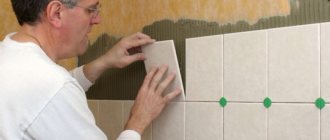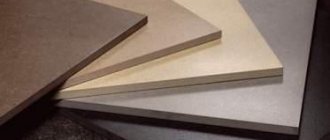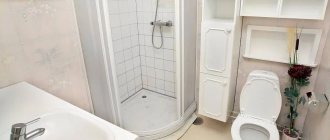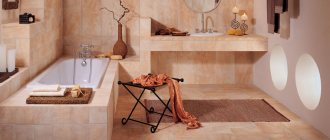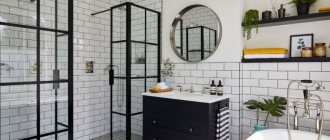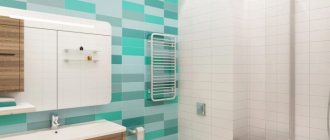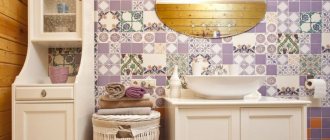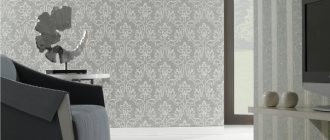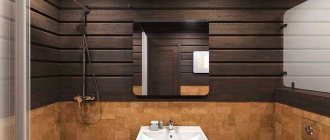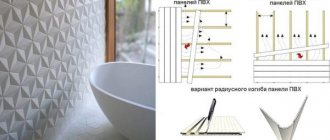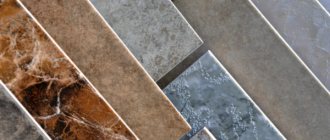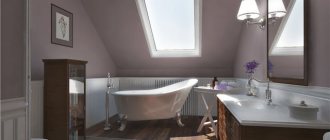From the point of view of aesthetics and sanitary conditions, tiling the bathroom is the most acceptable option. The tile is moisture-resistant, durable, and easy to clean. In addition, the widest range will allow tiling the bathroom in accordance with any idea or design idea. It is not difficult to lay the walls and floor with ceramic tiles with your own hands, the main thing is to purchase high-quality material so that it can easily withstand temperature changes, high levels of humidity, and exposure to steam. And then the bathroom renovation will delight the owners for a long time.
Decorating a bathroom with tiles
Modern trends include decor in the Scandinavian style, as well as in the loft and minimalist styles. Decor with relief tiles looks stylish and fashionable. Relief material will help divide the space into zones. Relief tiles with rich blue tints will look great.
Tiles that simulate brick look perfect in a variety of bathroom decor options. It is important to lay the tiles straight or at an angle. The design with herringbone masonry will look unusual. It is advisable to leave horizontal surfaces plain, without drawings or patterns.
- The bathroom will look original if it is decorated in cream and chocolate shades. For a long narrow bathtub, a milky beige shade with a relief texture is suitable. They can be used to lay out wide walls. For other parts of the room, brown tiles with a wicker texture are perfect.
- An excellent option would be to decorate the walls with mosaics. Mosaic is well suited for small partitions. It is better to decorate wide walls with wavy tiles. For mosaics, it is advisable to choose darker shades, for example, chocolate brown with splashes of gold.
- In a room with a combined bathroom, it would look nice to be faced with mosaics that imitate brick. It is suitable for the toilet and washbasin area. For the remaining walls, chocolate tiles in combination with plastic panels are suitable.
Currently, pixel cladding of the room is becoming relevant. Decorating with pixel mosaics is quite labor-intensive, but the result will exceed all expectations: the cladding will look stylish and modern. Pixel mosaic is best combined with milky beige tiles that imitate natural stone.
For a small area, tiles that imitate brick are well suited. The combination of light brown and milky white shades is relevant. The design will look good if the tiles are laid using the brick laying method: two to one.
Imitation of tiles imitating natural wood or antique does not lose popularity. If you plan to design a bathroom like wood, then it is advisable to use tiles of elongated sizes.
Decorating with large hexagonal tiles is suitable for antique-style wall cladding. A few decades ago, even floors were covered with hexagonal tiles. The shape of the tile allows you to create a variety of patterns.
Determining the type of wear resistance of the coating
Wear resistance is a parameter that determines the degree of wear of the coating, the length of time during which the appearance of the tile is preserved, subject to constant use.
The main thing is to choose materials in the same style and take into account the type of coating.
There are 5 levels of wear resistance.
- Lowest (PEI-I). Such products are delicate and weakly resistant to damage. They are used more often as decorative elements.
- Medium-resistant (PEI-II). It is used to cover floors in apartments or houses. Susceptible to microcracks.
- Quite durable. (PEI-III). The tiles withstand impacts well. More resistant to scratches and cracks. It is easy to clean from dirt and has a long service life.
- Persistent (PEI-IV). This material is very durable. Used for flooring in offices and staircases. Has a high price.
- Super resistant (PEI-V). The best in all respects. Such tiles are often called porcelain tiles.
A horizontal layout is preferable for a small room, but a vertical orientation will allow you to “raise” the ceiling, if necessary.
How to choose bathroom tiles
The tiles used to decorate bathrooms have their own distinctive features:
- Possibility to combine shades with each other. Before purchasing, you need to consider all the different types of tiles and their ability to combine with each other. A special collection should be displayed on display, including light and dark shades, borders, decorative elements and flooring samples.
- Quality of tiles. Bathroom tiles should have a glossy surface. This surface is easier to clean and easier to remove dirt and stains from. A good type of tile for a bathtub is one with a mosaic surface. Mosaic will hide all the unevenness and imperfections of the walls in the room. For flooring, it is advisable to choose matte tiles, since glossy tiles slip from moisture and will soon lose their shine.
- Suitable parameters. Everything is selected individually depending on the preferences of the buyer, but it is advisable to purchase tiles with dimensions of 60 by 20 cm, 50 by 20 cm and 60 by 30 cm. You should not purchase too large tiles or seamless tiles.
- Purchase of borders. The use of borders is a thing of the past; nowadays this cladding element is practically not used.
Combination of shades. The choice of color palette depends on the style of the bathroom. If the consumer is not sure, then it is better to opt for dark shades.
Tiling without trimming
Even if you already know how to choose tiles and what kind of tiles should be in the bathroom, there is still a decent chance that you will not get a quality result. This happens because for some reason most finishers do not know how to lay out corners without trimming.
When the wall does not fit a whole number of tiles and the master (more precisely, a handyman in such cases) either starts with a whole one and cuts to the corner as necessary, or combines the middle of the tile with the middle of the wall and goes in 2 directions, again making 2 cuts on the sides as in photo.
Rule for tiling bathroom corners to minimize undercutting:
- We count how many whole tiles fit on the wall and subtract one from this number.
- If we get an odd number, then the center will be the center of the whole tile.
- If even or 0, then there will be a seam in the center between two tiles.
This is pure mathematics. With this algorithm, the trims will always be symmetrical and no less than half the size of the whole one.
Let's rework the example above. 3 whole tiles would fit on the wall; 3-1=2; 2 - even. This means there should be a seam in the center. We use lazy photoshop.
Despite the fact that the rule is simple, there are a huge number of people who still do not know it. How not to do it.
And here is the correct layout:
The bathroom floor can be finished according to the same rule. Or take into account which part of the tile will be visible and which part will be hidden, for example, by a washbasin. Then you can start by laying the whole one in the visible part.
Options for wall tiles in the bathroom
In addition to dividing tiles into wall and floor, there is a division into certain types:
- Mosaic tiles contain porcelain stoneware and glass. Mosaic tiles are an environmentally friendly product, and the tile finish is strong and durable. The advantages include a large color palette and patterned coatings.
- Large-format porcelain tiles are characterized by increased durability and resistance to splitting during laying. There are options with both glossy and matte finishes.
- Tile is the most common material for finishing a room. It features a wide range of colors and a variety of textures.
The best manufacturers of bathroom tiles
An important criterion for choosing tiles is which company produces it, how proven and popular it is.
Russian
The following companies occupy leading positions in Russia:
| "Italon" | Azori | "Kerama Marazzi" |
| High quality premium tiles designed in the Italian classic style with aristocratic notes | The manufacturer produces material with a unique design, good quality, and wear resistance. | Manufactures tiles from ceramics and porcelain stoneware. Main advantages - quality, dimensional accuracy, long service life |
European
Among foreign manufacturers they choose:
| "InterCerama" | "Vivo" | "Keramin" |
| A developing brand in Ukraine. Tiles of excellent quality are produced according to all European standards | Chinese tiles, but very durable, last a long time. Good value for money | A Belarusian company whose main products are ceramic tiles with a glossy glazed finish. Reliable, strong, durable |
It is not necessary to give preference to imported material; domestic material is no worse in quality. Unless you like the design of foreign manufacturers more.
Types of flooring
For flooring options there are fewer options, there are the following types:
- Metlakh tiles are considered the most stable and frequently used material
- Clinker cladding is suitable for rooms with high levels of humidity, for example, a sauna. It washes off easily, is not slippery, and does not leave streaks.
- Glazed coating. It has increased strength and does not crack when laid. It is a material of increased brightness and does not lose it during operation.
- Pressed coating. Perfect for both modern and classic styles.
- With no enamel coating. Resistant material, does not slip, has sufficient hardness.
Mistakes in bathroom finishing design
A common mistake when decorating a bathroom is the use of inappropriate or incompatible materials.
It is not recommended to place the mirror cloth along the bathtub, since splashes of water and various products will fall on its surface, as a result of which there will always be spots, streaks and streaks on it.
In addition, you cannot paint the walls opposite which the faucet is located. Spraying water will cause the wall to quickly lose its original appearance.
Combination of tiles in small rooms
In order for the cladding to look advantageous, you need to understand in what combinations it can be used. There is a huge variety of options, thanks to which it is possible to create a unique design in a small space.
Decor in pink tones goes well with elongated marble tiles that look like tiles. It is advisable to do colored cladding in the middle of the room. This will help divide the room into zones and also pay special attention to this part.
- A bathroom with a shower can be decorated in light purple or pinkish-lilac shades, with horizontal tiling. An accent can be created using pixel cladding. Pixel mosaic helps to divide space into zones. It is suitable for decorating a shower or an area with a washbasin.
- A small room will look good in chocolate shades. It is advisable to alternate darker and lighter colors when laying horizontally.
- Cladding that imitates wood is combined not only with a variety of shades, but also with textures. Brown tiles with light walnut and identical colors will look good.
The advantage of tile is that it is easy to use and does not require special care. Thanks to the wide variety of colors and knowing all the subtleties of cladding, it is easy to create a unique room design.
Choice of colors and combinations
The overall impression of the bathroom depends on the choice of color, and incorrectly chosen color combinations can ruin even an expensive renovation.
Neutral colors
Neutral shades (white, beige, gray, light pink, ivory) are used for both small and spacious bathrooms. They visually enlarge the space and give a feeling of freedom and lightness. They are often used as the main background.
Bright shades
Bright colors are most often used to create accents. However, in bright and spacious rooms you can use them as the main background.
Designers advise placing several bright accessories on a neutral background or using one (and no more) bright color as a base color.
Bright shades in the interior.
Pastel colors
Pastel colors are suitable for any layout and area of the room. They create a cozy and warm atmosphere, filling the space with air and light.
Dark gamma
Dark colors cannot be used in small narrow bathrooms. Especially dark or bright ceilings. This will visually narrow the space and create a feeling of constriction and discomfort.
Dark colors are best used in large, well-lit rooms to add style and polish.
Light colors
Light colors are a good background for different combinations and textures. They visually expand the space and are suitable for both well-lit and darkened rooms. Using light shades, you can create accents on the walls.
Bright bathroom.
How to combine more than two colors
It is not recommended to use more than three different colors or more than 5 shades of 1 color in the interior. It is better to use 2 shades of the same color or take 2 contrasting ones and make a bright interior.
Otherwise, an imbalance will arise - an unpleasant feeling when being in such a room. Colors should emphasize and complement each other.
When decorating a bathroom in one color scheme, choose 1-2 more light or dark shades of the base color to create volume, highlight details and relief of surfaces.
You need to pay attention to the psychological perception of colors. Some shades can cause unpleasant associations and create a “pressure” effect (rich red, black, bright blue, snowy white, etc.). It will be uncomfortable to stay in such an interior for a long time.
Bathroom tile design photo
Use of porcelain stoneware
Durable ceramic tiles, better known as porcelain tiles, are commonly used for flooring. But recently, more and more often it can be found on the walls of small toilets. This cladding option is considered the most convenient. Typically, porcelain stoneware is large in size, so its installation will take much less time. And the variety of colors on the market allows you to use this finishing option to decorate a bathroom in any style.
Those who prefer minimalism in everything can be advised to decorate the walls in a small toilet with medium-sized glossy porcelain tiles.
If you choose dark tiles to decorate a small bathroom, then you need to take care of high-quality lighting in the room. Otherwise, it will not be comfortable to be here.
Porcelain tiles stylized as natural wood will look good in a modern interior.
Brickwork for bathtub cladding: what you need to know ↑
It is important not only to know how to tile a bathtub, but also to properly prepare the surface. Craftsmen take into account that the working area is limited in width and height. It will not be possible to perform standard half-brick masonry. The side of the bath is too narrow for such experiments and is not designed to fit the dimensions of a serial product.
Therefore, the brick is cut into two parts. For this, an angle grinder with a diamond disc is used. The work is carried out carefully in order to obtain the thinnest bricks as intact as possible. The partition is laid out, paying special attention to the vertical level - it is checked using a plumb line. The top row of masonry is glued directly to the bathtub with a special glue - this ensures a reliable connection between the building material and the tank.
Ideally, the thickness of the brick is calculated so that there is room left for applying a thin layer of plaster. With its help, all errors are leveled out. It is much easier to stick tiles onto such a surface. This option is possible if the protrusion of the side of the bathtub is more than 2 cm.
After drying, the plaster is treated with a fungicidal compound, primed and ceramic tiles are glued.
Instead of brick, foam concrete and similar materials are sometimes used. However, this is advisable if the slabs are used for other repair work and there are unused residues. It is irrational to buy bulk building materials specifically for a small project.
Brick is a material not intended for penetrating waterproofing. Cement plaster will serve as a moisture-protective layer.
Quite often, not only the facade of the bathtub is tiled, but also the horizontal section between the tank and the wall
Recommendations for choosing tiles for a small toilet
To visually expand a modest-sized room, you can use several effective techniques:
- decorate individual zones with mosaics or create panels from them;
- lay tiles diagonally;
- choose facing materials in cool shades;
- use tiles with a mirror surface;
- choose decor of abstract forms.
Very often, when decorating small bathrooms, designers divide the wall with a border horizontally. The shade of the upper part of the wall should be much lighter than the lower one. If you plan to use a decorative border, it is best to place it at eye level.
The optimal size of tiles that are planned to be used to decorate the wall in a small toilet is considered to be 10*10 and 15*15. The smaller the size of the material, the more it will be needed to decorate the room, and the wider the room will look.
Screen making
There are different types of screens used for the bathroom. Depending on the characteristics of the room and the required functions, brick, plasterboard, metal and aerated concrete models are used.
Brickwork
When designing a brick structure, you need to take into account the following features:
- The material is installed on the edge with a dressing of ½ stone.
- For cladding bathtubs with an oval, asymmetrical or semicircular shape, it is customary to use traditional masonry.
- The cement-sand mixture is diluted in proportions 1:4. In order to increase plasticity, add 1 tbsp per 10 liters of solution. l. detergent or liquid soap.
- Before tiling, the screen is plastered. The procedure is needed to mask visible surface defects.
- You need to leave 1-2 openings in the screen for a plumbing hatch.
- Plastering is done along beacons, on straight surfaces using a rule, and on radial surfaces - with a piece of plastic plinth or profile.
- Facing the side involves processing the perimeter to the thickness of the tile, which is 2.5-3 cm.
- If the project provides for a shelf along the perimeter of 1 or several sides, the masonry must be kept protruding outward.
When assembling the box to support the sides, it is necessary to adjust the height of the masonry.
Brick bath screen.
This is done according to the following instructions:
- The legs are attached to the bowl and the height is adjusted using a tape measure.
- The plumbing structure is installed on a layer of cardboard near the brick screen.
- Adjust the bowl feet.
The advantages of brick structures include:
- No difficulties with self-assembly.
- Durability and maintainability of the coating.
- There is no need to build a frame or drill into walls and flooring.
However, the technology also has its downsides. The number and size of openings for communications are limited.
If the structure is damaged, you will need to spend a lot of time on masonry, plastering and other procedures.
Plasterboard construction
To cover the bathtub, moisture-resistant series of plasterboard boards are used, which are not afraid of high humidity.
Bath screen made of moisture-resistant plasterboard.
During finishing work, the following nuances are taken into account:
- The frame is assembled from a galvanized profile.
- Hatch mounting posts are made of double profile.
- The frame is fixed to the walls and the lower floor slab.
- To cover radius or curved areas, the slab is soaked with a damp cloth or cut from the side of the smaller bend.
- As an alternative to conventional hatches, folding shelves, panels and drawers are used.
Plasterboard screen is popular due to:
- Minimum load on floor slabs and walls.
- Ease of assembly of partitions with complex configurations.
- High technology process.
- Possibility to build hatches of different sizes.
The disadvantage of plasterboard construction is the lack of maintainability.
In addition, the screen has to be attached to the load-bearing elements of the apartment. At home, you will need to drill into walls, partitions and floors in inconvenient places. During subsequent repairs, it is quite difficult to detach the tile from the sheet.
Aerated concrete blocks
To sew up a bathtub with aerated concrete, you need to evaluate the following features:
- The blocks are made to protrude outward to secure the shelf on the sides.
- If the finishing layer is flush with the side, then the internal elements of the blocks are ground to the dimensions of the structure.
- The slabs are fixed using both cement mortar and polyurethane foam with increased adhesive properties.
- It is better to make openings for hatches in masonry with horizontal slabs.
The method is characterized by minimal investment and high speed of action. The surface becomes smoother than when using brickwork, and it does not need additional putty.
Aerated concrete screen does not require additional preparation for laying tiles.
Metal base
For assembly, it is better to use a galvanized metal profile, which should be sheathed with extruded polystyrene foam.
The work is carried out according to the following instructions:
- First, the length of the bath is measured and a profile of suitable length is cut.
- The structure is cut every 3 cm.
- A profile is applied to the edge of the bathtub and fixed on one side with construction tape.
- To hold the formed structure, the perimeter of the bathtub is taped with tape.
- Next, the profile is detached from the sides and attached to the floor using dowels, and shifted to the thickness of the finish.
- If tiling is planned, its thickness and putty layer are taken into account.
The finished frame can be tiled, hiding all the seams and defects.
The need to make a screen under the bathtub
Screens under the bathroom are intended for both aesthetic and practical purposes. They are necessary to create a beautiful and functional niche in which you can store various small items and useful things.
A screen option under the bathtub that solves the problem of storing bath accessories.
Sliding structures allow you to quickly eliminate any failure in plumbing communications, check the drain siphon, or hide unused equipment.
Improved modifications of screens are equipped with shelves and drawers where you can organize various items.
Ideas for a small bathroom.
Bathrooms in Khrushchev are characterized by minimal sizes and inconvenience. To increase the space, you can combine a toilet and a bathtub, or use a shower stall. To decorate the walls, use classic rectangular ceramic tiles, placing them vertically, avoiding large parts. To disguise defects, use a stretch ceiling.
Mirrors will help to visually expand the space.
Choose tiles in bright colors. Contrasting finishes will enliven the interior. Tiles in light and pastel colors will help to visually expand the space. Do not use black or other dark colors for decoration. You can complement the design with mosaics or colored panels.
Correct laying of tiles will help to optically expand a small room. It is better to use the direct method, horizontal or vertical for walls, and diagonal for the floor. For the floor, it is better to take dark-colored tiles. Use material with a small pattern as decoration.
In the photo: Karakter Collection
Interesting design ideas for decorating rooms with bathroom tiles from Zodiac
We invite you to the ZODIAC “Interior & Ceramics” branded salons. Professional consultants will guide you through the variety of choices and help you decide on suitable materials.
Waiting for you!
Stylistic direction
The finishing option also depends on the chosen style. Each direction has its own characteristics. So, for style:
- Art Nouveau is characterized by bright colors and bold contrasts. This is a suitable option for a bathroom of any size;
- Provence is characterized by the use of tiles in restrained pastel colors. Thanks to this, it is possible to create a special romantic atmosphere in the bathroom. The best option is soft pink, lavender, sky blue tones. You can choose tiles decorated with small patterns of plant origin;
- Loft is characterized by sand and beige tones. Chocolate shade and brick color are quite popular;
- For classics, it is preferable to use high-quality expensive materials in soothing colors. The chosen finishing option should be in harmony with the furniture installed in the bathroom. A set made of expensive wood is preferred;
- High tech prefers to use facing material with a glossy surface. the desired effect is achieved by laying elements at different angles;
- Baroque prefers to lay tiles in the classical way. The finishing material should be in restrained pastel colors. With this approach, the bathroom will become the highlight of the house;
- Scandinavian people choose tiles of harmonious light shades. Elements with small ornaments look especially advantageous.
Thus, there are various options for finishing a bathroom with tiles. Designers actively vary the size, color and spatial arrangement of each element. As a result, it is possible to achieve a unique effect in a bathroom of any size. You just need to initially correctly place the emphasis and highlight goals for implementation.
